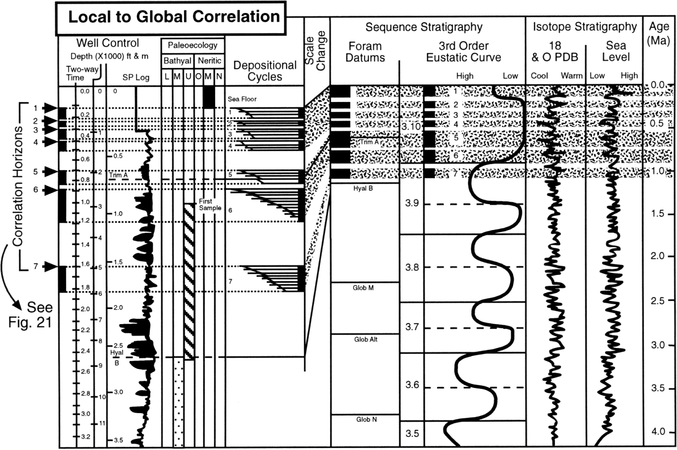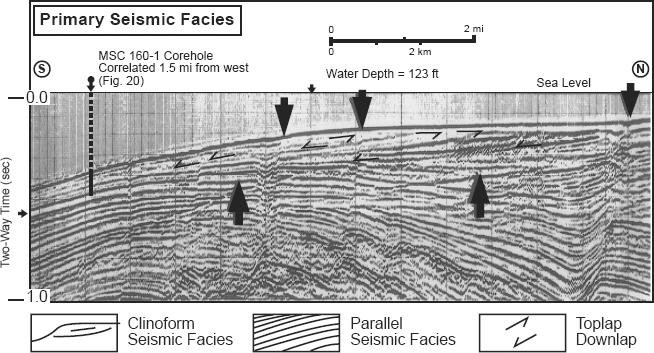Recognizing stacked depositional sequences in seismic profiles
| Exploring for Oil and Gas Traps | |

| |
| Series | Treatise in Petroleum Geology |
|---|---|
| Part | Critical elements of the petroleum system |
| Chapter | Sedimentary basin analysis |
| Author | John M. Armentrout |
| Link | Web page |
| Store | AAPG Store |
Depositional sequences can stack into successions of sequences if accommodation space permits preservation of successive sequences. Seismically, stacked sequences are expressed as repetitious reflection patterns.
GOM basin example
Figure 2 Seismic reflection profile from the East Breaks field area illustrating both clinoform and parallel reflection patterns in late Pleistocene sediments immediately below the sea floor (between two sets of bold arrows). Modified from Armentrout;[3] courtesy Gulf Coast SEPM.
The seismic reflection profile below is from the High Island South Addition area, GOM basin, distance::20 mi east of the East Breaks shelf-margin delta. It illustrates the vertical stacking of seven depositional sequences within a fault-bounded salt-withdrawal basin. Down arrows at the inflection point of each clinoform identify the top of the clinoform of each sequence. In general, each cycle consists of (1) a thick basinal package of relatively discontinuous, variable-amplitude, hummocky reflections that grade upward into (2) parallel, continuous, uniform amplitude reflections, overlain by (3) a prograding clinoform that downlaps the underlying facies. Each clinoform is interpreted as a shelf-margin delta prograding into this outer-shelf to upper-slope fault-bounded basin as shown by the presentday sea floor profile. The seven prograding clinoforms are mapped into a nearby well and are correlated with two-cycle charts (Figure 1). Cycle 1 of this figure correlates with the clinoform package of Figure 2.
Interpretation of example
The nearly vertical stacking of seven shelf-margin clinoforms suggests that accommodation space was created in the same area during seven cycles of progradation. The accommodation space is formed by down-to-the-north movement on the fault. This fault is part of a counter-regional listric growth fault that soles out into salt layers at depth. Movement on the fault occurred at a rate permitting the vertical stacking of shelf-margin clinoforms during each glacial/interglacial sea level cycle rather than progressive basinward progradation of successive clinoforms across a stable shelf-slope profile. This pattern clearly demonstrates the interplay of sediment supply, tectonics, climate, and sea level.[4][5]
See also
- East Breaks depositional sequence
- Definitions of depositional system elements
- Identifying depositional sequences
- Identifying depositional sequences in seismic sections
- Identifying depositional sequences from biostratigraphic data
- Recognizing stacked depositional sequences from well data
References
- ↑ Haq, B., J. Hardenbol, and P. R. Vail, 1988, Mesozoic and Cenozoic chronostratigraphy and cycles of sea-level change: SEPM Special Publication 42, p. 71–108.
- ↑ Williams, D. F., and D. M. Trainor, 1987, Integrated chemical stratigraphy of deep-water frontier areas of the northern Gulf of Mexico: Proceedings, Gulf Coast Section SEPM 8th Annual Research Conference, p. 151–158.
- ↑ 3.0 3.1 Armentrout, J. M., 1993, Relative seal-level variations and fault-salt response: offshore Texas examples: Proceedings, Gulf Coast Section SEPM 14th Annual Research Conference, p. 1–7.
- ↑ Beard, J., H., Sangree, J., B., Smith, L., A., 1982, Quaternary chronology, paleoclimate, depositional sequences, and eustatic cycles: AAPG Bulletin, vol. 66, p. 158–169.
- ↑ Anderson, R., N., Abdulah, K., Sarzalejo, S., Siringan, F., Thomas, M., A., 1996, Late Quaternary sedimentation and high-resolution sequence stratigraphy of the East Texas shelf, in DeBatist, M., Jacobs, P., eds., Geology of Siliciclastic Shelf Seas: Geological Society of London Special Publication 117, p. 94–124.

